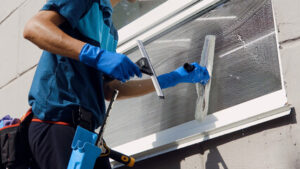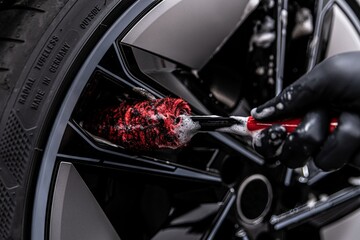Window Cleaning requires a bit of skill to get the results you want. Start by having a squeegee, and a lint-free cloth or newspaper.

For bigger windows, professionals recommend a snake technique. Starting in one corner of the window, pull the squeegee across the whole window, wiping the rubber blade clean between each pass.
The humble squeegee is one of the most important tools in your window cleaning arsenal. First used by sailors to clean windows on weathered ships, it’s since become a standard household item that’s essential for keeping your glass clear. It’s also a great way to get the job done quickly, without leaving streaks or spots behind.
Start by washing the glass with plenty of clean, soapy water. Any kitchen dish liquid will do the trick, but if you’re concerned about pollutants and bird excrement on your windows, use a 100-percent biodegradable soap that won’t harm plants outside or toddlers and pets who might touch the window sills inside.
When you’re ready to squeegee, wipe the rubber blade of your squeegee with a lint-free cloth or hand towel. Then, begin at the top of the window and work down to the bottom. Always work in an S-shape and wipe the squeegee between strokes to remove any residue and prevent dry spots from developing.
If you need to, move the squeegee handle up and down to shift the position of the blade. This will help you to reach hard-to-reach spots that are just out of your comfort zone. You can also try using the fanning technique, which is a quick overlapping stroke that you’ll need to practice to master.
Don’t use paper towels or newspapers, as they can leave lint streaks on the glass. Instead, use a lint-free microfiber cloth or rag that you can easily wash and reuse.
A squeegee should be easy to grip and comfortable in your hand. It’s a lot of pressure when you’re removing all that soapy water, so make sure the handle feels good in your hands and fits nicely in your handhole. Professional window cleaners often prefer a lightweight, aluminum squeegee that they can carry around all day without hurting their back or wrists.
If you’re serious about your window cleaning and want the best results possible, invest in a high-quality squeegee and wiper blades. These can be found at your local hardware store or a specialist window cleaning supplies shop.
Apply a Soapy Solution
If you don’t use a soapy solution to wash windows, you won’t be able to remove all the dirt and grime. The best window cleaning solution is one part white vinegar to ten parts water, as vinegar is an effective grime-cutting agent and the mixture produces no streaks. Add a bit of dish soap, such as Dawn, to the vinegar solution and you have an even more powerful cleaner with added grease-defeating properties. Distilled water is preferable because it doesn’t leave hard-water spots or mineral buildup on the glass.
When you’re ready to clean the windows, apply the solution with a microfiber cloth or newsprint. Avoid paper towels, which can leave fibers behind, and scrubby sponges, which can scratch the windows. If you don’t have lint-free microfiber cloths, a lint-free rag or a piece of old flannel can be used to wipe the windows. Be sure to apply the cleaner evenly, starting at the top and working down the windows, if applicable. When finished, be sure to rinse off the solution residue with a garden hose and then buff the windows with a dry microfiber cloth.
You can also buy special glass cleaner for windows that doesn’t have a harsh chemical smell and provides a good, even streak-free clean. Alternatively, you can make your own DIY window-cleaning solution by mixing equal parts white vinegar and warm water in a bucket. Add a bit of mild dish soap, such as Dawn, to the solution for extra cleaning power and grease-defeating ability. Pour the mixture into a spray bottle and label it. Store it in a cool, safe spot where children and pets can’t reach.
Don’t forget to clean the window screens when washing your windows, too. To do so, mix a quarter cup of dish soap and water in a bucket, then soak the screens with the solution and squeegee off all the dirt. Be sure to rinse the screens well so that the water doesn’t leave a sticky residue on them. Once the screen is rinsed, let it dry completely before reinstalling it on your sparkling clean windows.
Loosen Sticky Residue
Sticky residues are often the cause of obstinate stains that don’t easily disappear from windows and other glass surfaces. They may be the leftovers of clingy film decorations, stickers or glues, or even paint, tar or silicon caulking byproducts. Some residues can be solved by using soapy water, but others require the action of solvents and stronger detergents. Removing stubborn stains is important not only for aesthetic reasons, but also because they can obscure our view and attract dirt and dust particles that are hard to remove.
Before trying chemical or commercial cleaners, try applying some heat to the affected area of the window glass. This can loosen the sticky residue and make it easier to remove with a plastic scraper or old credit card. Rubbing alcohol and nail polish remover can also be used to loosen residues. Apply them to a cloth or a piece of paper and press onto the sticky spot, letting it sit for about a minute or so.
Once the residue is loosened, you can scrape it off with a plastic scraper or a razor blade. When scraping, use a sharp blade and a smooth, rather than slicing, motion to avoid scratching the glass surface. If you don’t want to risk scratching the glass or if these options have failed, try using a product designed for cleaning grease and oil from metals and plastics. These can usually be purchased from hardware stores.
Another option is to soak the glass in a solution of equal parts water and vinegar. Leave it to rest for a few minutes before rubbing the residue with a non-abrasive scrub pad. When the residue is gone, you can rinse off the glass with a power washer that’s equipped with a soap dispenser. Be sure to choose a soap that’s safe for the type of power washer you have and follow the manufacturer’s instructions. Then, dry the glass with a soft cloth to prevent spots or streaking. The cleaning process can be time consuming, but it is worth the effort to get rid of stubborn residues that can spoil the appearance and diminish the function of the windows.
Dry the Glass
When you’re done wiping down windows, make sure to dry them thoroughly before squeegeeing. Doing this eliminates water spots and helps prevent smudges and streaks from forming. One way to do this is to use a paper towel or microfiber cloth to wipe down each window. Another option is to crumple up a piece of newspaper and wipe the windows down with it. This will absorb any remaining moisture and help your squeegee leave the glass with a streak-free shine.
For smudges that won’t go away with soapy water or a squeegee, try using mineral spirits or Pine-Sol. Both are non-abrasive and will help break down stuck-on residues without scratching the glass or frames. Just be sure to follow the manufacturer’s instructions for safe and effective use.
There are also a number of specialty products available to remove stubborn stains from glass. For example, a specialized cleaning solution can be applied with a sponge or cloth to dissolve paint specks and labels from glass windows and doors. These specialized cleaners are designed to be used sparingly and are typically recommended by professional window cleaners as a last resort for particularly difficult stains.
In addition to a variety of cleaning solutions, there are many types of equipment that can be used to clean glass windows and doors. Supported scaffolding, which is a temporary platform workers can stand on that rests on a surface below rather than hanging from above like suspended scaffolding, is often used to reach higher windows and is commonly found in commercial settings. For windows that are hard to reach, you may also want to consider a telescoping pole that can extend more than five feet and is used for washing high windows.
If you have glass that is very cloudy, you can use white vinegar to clean it. This natural and safe cleaner can dissolving mineral deposits, breaks down grime, and leaves fewer streaks than some commercial cleaners. To use distilled white vinegar, mix equal parts with water and spray the solution onto the glass. Wipe down the glass and rinse well with a lint-free cloth before drying it. For especially tough stains, you can also try using isopropyl alcohol or baking soda on the spot.

